|
'Ruler' Class
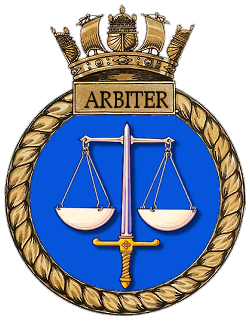
Description
Blazon (Heraldic description)
On a blue field, a sword proper, pommel and hilt gold, debruised below the point by a pair of scales, white.
ARBITER: One who is empowered to judge in a dispute. The design reflects the balance of power (the scales of justice) and retribution (the sword).
For explanations of heraldic terms see the Badges & Honours page.
Motto:
"JUS TITIA EX CAELi"
Justice from the skies
|
|
Pennant Numbers:
D31 (Atlantic)
R303
/
A387 (Pacific)
Battle Honours:
Atlantic 1944
|
|
|
Specifications
Builder: Seattle-Tacoma Shipbuilding Co. Tacoma, Washington
Completed by: Commercial Iron Works, Portland, Oregon
Displacement: 15,390 tons
Length (Overall): 494ft 9in
Beam: 69ft 6in
Flight deck: 450ft x 80ft wood covered mild steel plate
Propulsion: 2 Foster Wheeler boilers; 1 x Allis-Chalmers geared
turbine driving 1 shaft
Speed: 16 knots
A/C Capacity: 20
Hangar: 260ft x 62ft x 18ft
A/C lifts: 2, Aft 34ft long x 42ft wide; forward 42ft long x 34ft
wide
Arrestor wires: 9 with 3 barriers
Catapult: 1 H4C hydraulic
Armament: 2 single 5in USN Mk 12, 8 twin 40mm Bofors, 14 twin 20rnm
Oerlikon, 7 single 20mm Oerlikon
Crew Complement: 646
Commanding Officers:
Capt. R.C. Harry
Dec 43 - Dec 44
Capt. D.H. Everett
Dec 44 - Aug 45
Squadrons:
853
April - June 44 Avenger
1820
(Ferry)
July 44 Helldiver
1843
Feb - June 45 Corsairs
Listen to this section


Click here to see more photos
|
|
A History of HMS ARBITER
|
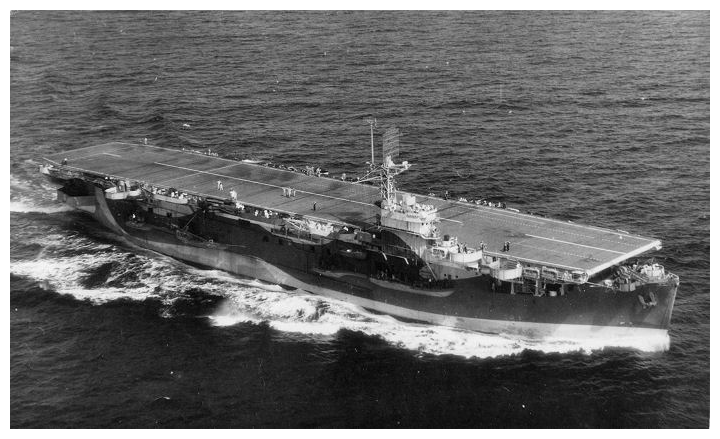 |
HMS ARBITER at sea in 1944. Photo: courtesy Maurice
Ayling |
ARBITER was a 'Ameer' class escort carrier built in the USA at
Seattle-Tacoma Shipbuilding Co. Tacoma, Washington; her keel being
laid down April 26th 1943 as the USS ST SIMON, CVE-51, a
'Prince William' class escort carrier. She was launched on September
9th 1943 by her sponsor, Mrs. R. H. Lewis, the wife of Major General
R. H. Lewis, Commanding General, North-western Sector, Fort Lewis,
Washington. CVE-51 was assigned to Commercial Iron Works, Portland,
Oregon, for the completion of construction. The 'Ameer' class
carriers were the third group of escort carriers built in the USA
for the Royal Navy, and were generally similar to the preceding
'Attacker' class.
Modification and preparation to enter service:
CVE 51
was transferred into the Royal Navy at Portland, on December 31st
1943 and commissioned as H.M.S. ARBITER, under the command of
Captain R.C. Harry. After completing her builder's sea trials and
Admiralty acceptance tests HMS ARBITER proceeded to Vancouver,
Canada to be modified to meet Admiralty requirements, receive her
full crew compliment, and work up ready for beginning her active
service.
This
work was undertaken by the Burrard Dry Dock Co. Ltd., North
Vancouver, British Columbia. ARBITER was the eleventh ship to be
modified by Burrards, and she arrived at Vancouver at on January 9th
1944 and was berthed in the pool while waiting to enter the yard; at
this time sister CVEs
SPEAKER,
QUEEN, and
RULER were in the hands of the Burrard's yard in front of her,
at various stages of modification,
NABOB and
PREMIER were completing. Work commenced to de-store ARBITER in
preparation for her modification work to commence and on the 17th
she was moved to number 8 berth at Lapointe Pier where her
alteration work began: this work totalled 150 separate modifications
and included lengthening of the flight deck, fitting redesigned
flying controls and fighter direction layout, modifications to
hangar, accommodation and store rooms, installing extra safety
measures including major changes to the aviation fuel stowage and
oiling at sea arrangements,, modifying gunnery and other internal
communications, adding extra W/T and R/T sets, and improved darken
ship arrangements.
As
work progressed ARBITER progressed through the yards various berths;
the yard could be working on six different ships at any time with
separate aspects of the work carried out at different berths, the
ships passing through like a production line, moving from one berth
to another until complete. ARBITER moved to No 3 on January 29th,
then to No 4 February 3rd and No 5 February 20th where her
alterations were completed on March 2nd. She was moved again to No 8
berth on March 4th to complete re-storing and embarking equipment.
ARBITER sailed for Esquimalt, Victoria, North Vancouver on March
13tth to enter dry dock for the fitting of additional sea valves and
other remedial work. She was un-docked on the 16th and began
preparing for her work up and post modification shakedown.
ARBITER also made a round trip to the US Naval Yard at Bremerton,
Washington to ammunition the ship and then return to the Straits of
Georgia (between Vancouver Island and the mainland), for steaming,
gunnery, radar and other trials and exercises. On her return to
Esquimalt she embarked Confidential Books and more stores. Sadly on
Sunday, March 19th during this working up period two crew members,
Leading Seaman George and Ordinary Seaman Hayes, were lost overboard
and were drowned.
Maiden voyage: 853 Squadron and a ferry trip to Liverpool, April -
June 1944
At the
beginning of April HMS ARBITER embarked the 12 Avengers of 853 naval
air squadron from the RCAF base at Sea Island, Vancouver; the
squadron had flown from USNAS Squantum on the US east coast to work
up and join ARBITER at Vancouver. The Avengers flew out to the ship
on the 5th and 6th of April for deck landing practice and to work up
the ships air department and flight deck parties. On completion of
training on the 5th the aircraft were struck down into the hanger
and ARBITER sailed from Vancouver on her maiden operational voyage.
The
ship reached San Diego, California on the 9th where more stores and
equipment were loaded. ARBITER put to sea on the 11th for flying
exercises and completed 12 sorties without incident before flying
was curtailed by high winds and the ship returned to San Diego on
the 13th.
ARBITER departed San Diego for the Panama Canal on the 17th of April
1944 and it was intended that further flying exercises would be
conducted, on passage to Balboa however weather conditions, the wind
being first too strong and then too weak, meant only a curtailed
programme was possible. 853 squadron aircraft managed fourteen
training sorties but suffered two accidents; one aircraft, JZ410
flown by Sub Lt. RD Pepler crashed into the ship's island
superstructure when landing-on on April 17th. Another, JZ394 flown
by Sub Lt. ME Gall ended up with a wheel in the port catwalk on
Friday the 21st resulting in the death of Able Seaman H. Jones.
Shortly before arriving at Balboa the ship's engines broke down and
she had to be towed into port, arriving there on April 25th. It was
to take eight days before repairs were completed and the ship could
proceed through the Panama Canal to Cristobal; from here she sailed
for Norfolk, Virginia. The squadron resumed flying on May 8th,
completing five training sorties before the wind strength fell,
during launches for a second exercise JZ517, stalled, turned
violently to port and crashed into the sea on the port side. The
pilot Sub Lt. AG Sandison was rescued by the escort, USS REHOBARTH.
Flying resumed on the following day, but after only six training
sorties all flying was cancelled when the ships engines stopped sue
to salt water in the boilers. A similar take off accident happened
on the 9th when JZ396 stalled on take off and crashed into
Caribbean; again the three man crew, Sub Lt. AG Sandison, Sub Lt. K
Hyde & Leading Airman J Crosgh, were rescued by the escort, USS
REHOBARTH the navigator Sub Lt. Hyde received serious injuries.
Flying
training resumed on the next day, but was halted again after six
sorties when the ship had to heave to when salt water was found to
have entered in the boilers. The engines were shut down and would
require dockyard assistance to start up again. So for the second
time in three weeks HMS ARBITER was towed into port, this time to
the US Navy base at Guantanamo Bay in Cuba; repairs were to take
five days, ARBITER resumed her voyage to Norfolk on the 15th but
this time without an escort which meant that no further flying was
possible. At Norfolk the ship was taken into dockyard hands for a
two week programme of defect rectification before sailing on to New
York, arriving on the 31st.
While
alongside at Staten Island, she began loading a deck cargo of
Corsair aircraft for delivery to the UK, 853 squadron's machines
were stowed in the hanger and no further flying was possible. On
June 2nd ARBITER was allocated to Western Approaches Command as a
ferry carrier. HMS ARBITER sailed from New York on 'D' Day, June 6th
1944, joining the east bound convoy CU 27 for the UK; also in this
convoy was her sister CVE
SMITER
also making her first Atlantic crossing as a ferry carrier. HMS
ARBITER arrived at the King George V dock in Glasgow on the 20th of
June; the Corsair aircraft were unloaded by crane onto the dockside
and towed to the nearby Renfrew airfield. The Avengers of 853
squadron were also unloaded; the squadron was to fly to
RNAS Machrihanish
ending its association with ARBITER.
Second Ferry trip: Round trip, Liverpool to Norfolk, Va., June -
July 1944
After
a quick turn around ARBITER and
SMITER sailed from the UK on June 23rd in Convoy UC 27; on July
3rd ARBITER, in company with her escort the USS SIMMS and a Fleet
Oiler the USS CHIWAWA, left the convoy bound for Norfolk, Virginia.
ARBITER docked at Pier 7, Naval Operating Base Norfolk the next day
and embarked 65 boxes of Secret Armament Stores On the 5th the
flying personnel of 1820 naval air squadron arrived on board, their
9 Helldiver aircraft and the squadron maintenance personnel
embarking the next day; also loaded on the 6th were 2 cases of TBR
mainplanes and a Cadillac. The morning of July 7th saw ARBITER
loading aircraft (44 Hellcats, 7 Corsairs and 2 Martlets) for
ferrying to the UK as deck cargo. Once loading was complete she
proceeded to New York where she was berthed at 35th Street Pier
Brooklyn on July 8th to embark passengers (11 women, 7 children, 21
boys, 76 Ratings and 2 Officers); once all passengers were aboard
the ship joined Convoy CU 31, sailing on July 10th 1944.
HMS
ARBITER anchored in Liverpool Bay late on July 21st to wait docking
at Gladstone Dock, Liverpool; however a fouled anchor prevented
ARBITER from getting under way until the morning of the 23rd when
she finally tied up to disembark her passengers and the consignment
of secret armament stores were unload ed. The following day 1820
squadron personnel, aircraft and cargo were disembarked; 1820 going
to RNAS Speke.
Third Ferry trip: Round trip, Liverpool to Norfolk, Va. and
refit, August 1944 - January 1945
ARBITER was to make one final run to Norfolk, Virginia, during
August, sailing with convoy UC 31 on the 9th for further load of
mixed American aircraft types. ARBITER, in company with the CVE
PATROLLER sailed for the UK in convoy CU 37, departing New York
on August 27th and arriving in the UK on September 7th; ARBITER
docking at Gl,asgow and
PATROLLER at Liverpool. After unloading this cargo ARBITER was
ordered to the Harland & Wolf ship Yard in Belfast for a
'tropicalisation' refit which commenced on September 12th. Whilst in
Belfast the ship's company were given 7 days home leave, each watch
taking their turn.
Work up and preparation for joining the BPF: January - March 1945
In
early January 1945 ARBITER commenced sea trials in Belfast Lough;
she was allocated to the British Pacific Fleet for operations as a
ferry carrier on January 30th. ARBITER's new squadron embarked on
February 14th when the 24 Corsair IVs of
1843 squadron
began a flying program in preparation for passage to Australia.
1843
was to suffer its first of three flying accidents after only four
days of training while the ship was steaming off Cumbrae light in
the firth of Clyde. On Sunday, 18 February 1945 Sub Lt Scarrott was
killed when his Corsair, KD582, turned sharply and dove into the sea
on take off; an elevator was been damaged by the prop of another
aircraft while running up on the flight deck. This was spotted prior
to take off but too late to abort the launch. The same prop damage
was inflicted on KD599 piloted by Sub Lt Ingram, but he was able to
abort his launch. The third incident involved Sub Lt. Rouse who
caught the last arrestor wire and put his Corsair, KD594 into the
number 3 barrier.
The
squadron suffered 17 incidents during its association with ARBITER,
mostly barrier crashes. Two of the most spectacular (and
photographed) incidents involved Sub Lt Appleton, who managed to put
an aircraft into each of the flight deck catwalks; On February 22nd
while landing in KD611 he caught number 4 wire and drifted sharply
to port, the port undercarriage leg running into the walkway where
the aircraft became firmly stuck. On March 22nd he lost sight of the
Deck Landing Control Officer and flew KD607 into the starboard
walkway, the aircraft fell overboard, removing an anti aircraft gun
mounting as it went.
|
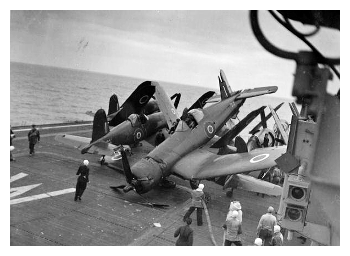 |
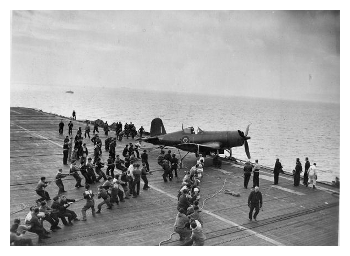 |
Left: Members of the flight deck party attempting to
haul Corsair KD611 out of the Port catwalk, February
22nd 1945.
Right: Corsair KD578 where she came to rest after
striking the rounddown and clearing the barrier on March
13th 1945. Photos: courtesy Maurice Ayling |
On Passage: Greenock to Sydney March 1st - May 1st
HMS
ARBITER sailed from the Clyde on March 1st bound for Australia. The
ship's first port of call was Gibraltar on the 9th where ARBITER
stored ship before transiting the Mediterranean, for Port Said.
Flying continued, and on the 13th Sub Lt W Noble had a
spectacular crash in corsair KD578 when it hit the rounddown on
landing, ripping off the tail oleo the aircraft crashed through
Nos.2 & 3 barriers before coming to rest on its nose, facing aft,
feet away from the forward deck park which was full of aircraft.
ARBITER arrived at Port Said on March 18th; Crewman Able
Seaman J.A. Phillips passed away as a result of illness on Friday
the 16th.
After
mooring at E3 berth overnight and having refuelled ARBITER proceeded
through the Suez Canal. After a stop at Port Suez on the southern
end of the canal ARBITER made for Bombay, calling at Aden to take on
more fuel, arriving at Bombay on March 28th. The next leg took
ARBITER to Colombo on the west coast of Ceylon; she entered Colombo
harbour on Sunday April 1st. The following day another crew member,
P.O. Radio Mechanic A.J. Page, died aboard ship.
|
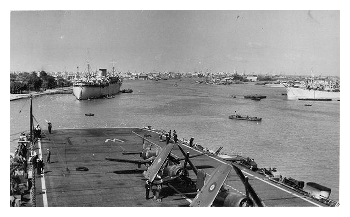 |
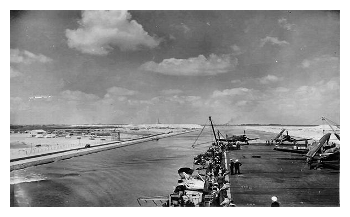 |
HMS ARBITER at Port Said after transit of the Suez
Canal, March 18th 1945.
Photo courtesy Maurice Ayling. Right, HMS ARBITER
passing through the Suez Canal March 19th 1945.
Photo courtesy Norman Phips |
ARBITER weighed anchor at 14:15 on April 3rd and sailed for a round
trip to Cochin, S. India to collect replacement airframes, and
stores not available in Australia, and arrived back in Ceylon at
Trincomalee on the east side of the island on the 8th. Some of
1843
squadron's aircraft had disembarked to the RN Air Station at
Colombo Racecourse before the ship sailed for
Cochin; they operated there until April 13th before rejoining
the ship which was anchored at Trincomalee.
From
Trincomalee the ship made a non-stop voyage to Sydney, Australia;
the traditional 'Crossing the line' ceremony was observed in the
Indian Ocean as they crossed the equator. 1843 squadron was flown
off to RNAS Schofields, on the outskirts of Sydney on May 2nd 1945
before ARBITER entered Sydney Harbour on and secured alongside
number 4 berth at Woolloomooloo.
A voyage to Manus: May - June 1945
While
alongside at Woolloomooloo the personnel and stores of
1843 squadron were off loaded and transported to
Schofields as the ship prepared for its first operational voyage as
part of the of the British Pacific Fleet. It had been decided that
in addition to her role as a ferry and replenishment carrier ARBITER
was to embark half of Maintenance, Storage & Reserve Unit No.5
(M.S.R.5) to service and maintain a stock of spare aircraft as part
of the Forward Aircraft Poll (F.A.P.). The other half was embarked
in HMS
CHASER with the same purpose. M.S.R.5 embarked on May 15th and
spare aircraft were loaded for transport to the forward base at
Ponam in the Admiralty Islands.
Also
embarked for ferrying to
RNAS Ponam were the personnel and equipment of M.S.R. 6 which
was embarked on the 18th: this unit was to be attached to HMS
NABARON, Mobile Naval Air Base (MONAB) No. 4, which had been
installed on the US Naval Airstrip on Ponam. Finally, a detachment
of 1843 squadron maintenance personnel rejoined ARBITER just before
she sailed for Admiralty Islands on May 20th. The Corsairs of
1843 had been hoisted aboard stored in the hanger with a
single aircraft ranged on deck ready to be catapulted; had the need
arisen to launch this aircraft it could not have returned to ARBITER
because the flight deck was covered in crates, vehicles and other
deck cargo for unloading at Manus.
While
on passage to Manus a serious incident occurred on Wednesday May
23rd when an undetected petrol leak caused a build up of fumes in
the aircraft refuelling machinery compartment. When three ratings
entered the compartment to shut the system down they were overcome
by the fumes. When Engineering Sub Lt. Jackson went to investigate
he discovered the unconscious men and managed to rescue one using a
length of rope before he too was overcome. The next man to enter the
compartment, A.A.3 McGale, managed to haul Sub Lt. Jackson out
before he also became affected by the fumes and could not re-enter
the compartment. At this point Stoker C.P.O. Pascoe arrived wearing
Salvas breathing apparatus; he entered the compartment to affect a
rescue but it was soon discovered that the breathing set was not
effective against petrol vapour. A pattern 230 self-breather set was
fetched and wearing this Chief Pascoe successfully recovered the two
remaining ratings from the compartment. Sadly one of these men,
Leading Stoker Paul Whittaker later died; he was later buried at
sea. Chief Pascoe was to receive the British Empire Medal for his
actions.
Nearing New Guinea, ARBITER hit bad weather, huge waves broke
over the flight deck and, despite being securely lashed down, and
several crates were washed overboard. During the height of the storm
the ARBITER began to roll quite alarmingly but her full tanks of
aviation fuel and oil acting as ballast, she would have been in
danger turning turtle. Once the storm was over the Corsair lashed
down on the catapult was checked over; it had not suffered any
damage during the storm.
On
reaching Manus and mooring in Seeadler Harbour ARBITER began
unloading stores and equipment for the BPF forward base; on
completion she weighed anchor and proceeding to Ponam Island, 22
miles up the coast to off load M.S.R. 6 and the aircraft of
1843 squadron. The squadron aircraft were the last items
to be disembarked to
RNAS Ponam on May 31st; unloading was a long slow progress since
Ponam was surrounded by a coral ringed lagoon, all stores, vehicles
and aircraft that could not be flown ashore had to be hoisted
outboard using the ship's derricks and ferried ashore on motorized
lighters. 1843 spent three weeks ashore conducting flying training.
It is not clear what ARBITER's tasking was during this period,
presumably conducting flying training, as 1843 was a 'spare'
squadron and ARBITER had not yet been assigned to replenishment
duties. However she appears to have been experiencing engine trouble
while at Manus, sufficiently serious to require full speed trials
early on June 22nd prior to proceeding to Ponam to embark aircraft
on June 25th.
ARBITER sailed for Brisbane later that day. Arriving off the
Brisbane coast on July 4th the squadron was flown off to RNAS
Maryborough, Queensland; this was the end of the squadrons
association with ARBITER,
1843 was to eventually join a spare Air Group, 3 Carrier Air
Group, which formed at RNAS Nowra a month later.
|
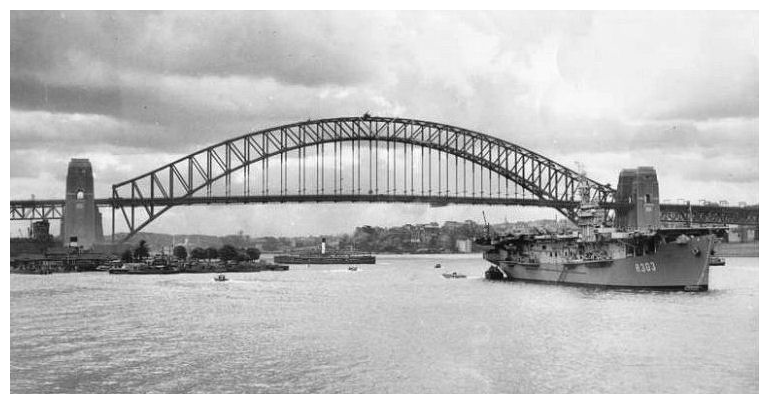 |
HMS ARBITER at anchor in Sydney Harbour, May 1945.
Photo courtesy Norman Phips |
Operations with 30 ACS: First replenishment sortie, July 1945
Upon
her return to Manus on 9th July 1945, HMS ARBITER joined 30th
Aircraft Carrier Squadron as a replenishment carrier with the BPF
Fleet Train. For her first replenishment trip she joined BPF Task
Unit 112.2.6 which comprised HM Ships ARBITER,
CHASER,
SPEAKER, &
STRIKER (Flag 30 ACS), with escorts HMAS NIZAM and HMAS NAPIER,
and the Victualling Store Issue Ship (VSIS) GLENARTNEY.
At
Manus ARBITER embarked her replenishment load, typically this was a
mix of 24 aircraft 9 Seafires, 7 Avengers, 6 Corsairs, 1 Hellcat and
1 Firefly, however Corsair loses were higher than projected so extra
Corsairs were carried. TU 112.2.6 proceeded to San Pedro Bay, Leyte
and then on to the pacific fleet service area, codename 'British
Tizzy' where on the 17th they were joined by HMS INDEFATIGABLE,
escorted by destroyers WRANGLER and WAKEFUL. The following day the
main Task force TF57 arrived to replenish before beginning
operations against the Japanese home islands. On 19th July ARBITER
issued four replacement corsairs. ARBITER issued replacement
airframes on the 20th, issuing 9 Corsairs, and 1 Seafire; one
Corsair KD655 piloted by Sub Lt Smith crashed into the sea on take
off. She received 5 corsair 'flyable duds'. On the 21st ARBITER
receiving 1 Seafire in the morning, which crashed into the Island
superstructure; on cleared she began flying off her remaining
Seafires two of which went unserviceable after a collision on the
flight deck. She then issued stores to six escort vessels before she
withdrew from the service area early in the afternoon. She headed
back to Manus with her escort HMAS NIZAM, to restock her replacement
airframes, arriving there on the 27th.
From
July 28th two CVEs were on station in the refuelling area at a time;
the four replenishment carriers made five sorties to the fleet
service area, ARBITER making two sorties,
STRIKER,
SPEAKER, and
CHASER one each. A fifth CVE,
RULER remained on station to provide Combat Air Patrols (CAPs)
throughout operations, in addition
RULER
carried a further ready use stock of aircraft for issue when the
replenishment carriers were absent.
Operations with 30 ACS: Second replenishment sortie, August 1945
At
Manus ARBITER exchanged unserviceable aircraft and embarked a second
replenishment load; she also received some modifications to her
oiling equipment while in harbour, this converting her to an
'auxiliary oiler' in response to the need for a means to supplement
the hard pressed tankers. This modification was also to be applied
to HMS RULER when she returned to Manus.
Returning to the service area ARBITER operated as part of Task Unit
112.2.5 with the tankers OLNA, WAVE KING, DINGLEDALE and SAN AMADO;
VSIS GLENARTNEY and FORT WRANGELL; CVEs
CHASER
and
RULER (CAP); sloops NORMAN, NIZAM, PHEASANT and CRANE, frigate
BARLE; minesweepers BALLARAT and BURNIE; hospital ship TJITJALENGKA.
This Task Unit proceeded to rendezvous with Task Force 37 in the
vicinity of Saipan, in preparation for air strikes on Japan plan for
9-10 August. Replenishment was completed on the 6th ARBITER issuing
10 Seafire, 6 Corsairs, 1 Avenger and 1 Firefly; she received 3
'flyable duds', 1 Avenger and 2 Seafires. On the 7th ARBITER
operated as an auxiliary Oiler fuelling vessel of TF 37. When her
replenishment duties were completed ARBITER withdrew on the
afternoon of the 7th; she was ordered to return to Sydney, via
Manus.
|
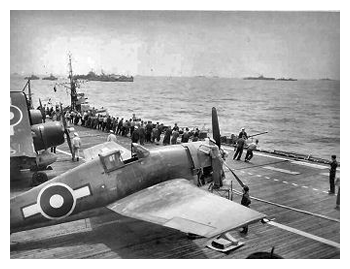 |
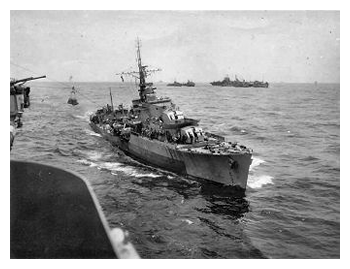 |
Left, A Hellcat and two Corsairs are seen here on the
flight deck of ARBITER during one of her replenishment
sorties; other vessels of the BPF and fleet train
surround her. Right, ARBITER delivering the mail- bags
of mail are passed by jackstay transfer to one of the
escort ships of the BPF during a replenishment sortie.
Photos courtesy Norman Phips |
Deck Landing Training and Ferry duties: August 15 - September 15
On her
arrival in Australian waters ARBITER was ordered to undertake a
period of flying training off Brisbane. She was steaming off the
Queensland coast providing Deck landing practice for pupils of No.2
Seafire conversion course operated by 899 squadron which had flown
out from RNAS Maryborough (MONAB 6) when Victory over Japan was
announced on August 15th. On completion of this training ARBITER
continued on to Sydney. The ship undertook a second, intensive deck
landing training session with 899 squadron in Hervey bay, Queensland
between September 10th - 13th to complete the deck landing
qualification phase of No. 3 course. Later on the 13th she tied up
at Bretts wharf, Hamilton, Brisbane to load aircraft and stores for
ferrying to Sydney. She arrived in Sydney on the 15th and began
preparations for a round trip to Hong Kong via Manus and Leyte.
Round trip Sydney to Hong Kong; September 19 - October 26
ARBITER sailed from Sydney on the early evening of September 19th on
the first leg of her humanitarian voyage to Hong Kong; she arrived
at Manus on the 25th to exchange stores and passengers before
proceeding to Leyte the next day. The ship called at Leyte for only
a few hours before continuing on to Hong Kong where she arrived in
the early afternoon of October 3rd. She anchored in the harbour for
the first night, moving to a mooring at Halt's Wharf on the 6th to
begin unloading stores and medical supplies; no shore leave was
granted. On October 10th Captain Everett left the ship to be
appointed as Commodore Hong Kong, the command of ARBITER passing to
the Executive Officer. ARBITER remained alongside until the 15th
when she sailed for the return voyage to Sydney carrying civilian
and military former prisoners of war for repatriation to Australia.
Shortly after leaving the ship was found to be infected by lice
(presumably passed onboard from the 'bum' boats that crowded the
harbour) and the ship required delousing. Upon her arrival back in
Sydney on October 26th and secured alongside at berth No.14
Pierpoint to disembark civilian passengers. On the 29th she was
moved to No.2 berth at
Woolloomooloo
Passage home to the UK: November - January
Having
restored with medical supplies and food ARBITER sailed again for
Hong Kong, arriving on December 3rd; this time leave was granted
while the ship made preparations for the voyage home to the UK;
again she was carrying a mixture of civilians, including women and
children together with military personnel and former PoWs. ARBITER
Sailed from Hong Kong on December 13th bound for Manila, then on to
Singapore arriving there on the 17th. From Singapore she went to
Trincomalee, on to Aden and then through the Suez Canal reaching
Port Said on New Year's Day 1946 A children's party was held on
Christmas day, somewhere in the Indian Ocean, the First Lieutenant
performing the duties of Santa. ARBITER called briefly at Gibraltar
on January 5th and reached landfall of the UK at Land's End on the
8th. She unloaded her passengers at the tail o' the bank on the
Clyde on January 10th 1946 and was reallocated to Rosyth Command.
Disposal: Return to US Custody
ARBITER the Clyde for Portsmouth on February 6th to be further
de-stored in preparation for her decommissioning. The work competed
she departed Portsmouth February 12th and arrived at the US Navy
dockyard, Norfolk, Virginia on February 23rd 1946 and
decommissioned. She was officially handed back to the US Navy on
March 3rd 1946.
CVE
-51 was struck from the US Navy list on 12 April 1946, and placed on
the disposal list. The ship was sold to the Newport News
Shipbuilding and Dry Dock Co., Newport News, Virginia, on 30 January
1947. She was converted to the cargo ship CORACERO for the
Dodero Navigation Company, Argentina, being delivered on 12 January
1848. She was sold on to the Philippine President Shipping Lines and
renamed PRESIDENT MACAPAGAL from 1965 to 1972. Finally she
was renamed LUCKY TWO in 1972 for passage to the breakers
yard be scrapped at Kaohsiung, Taiwan, in 1973.
Content revised:
31 October 2021
Sources used in compiling this account:
Click here for a list of
Primary sources
Additional sources:
Ayling. M., (2003) 'Ayling and 1843 Squadron~ "The
Ambassadors" unpublished memoir (author's collection)
Ward, P., (2005) 'Pacific Voyage: A Year on the Escort
Carrier HMS ARBITER in WWII' Studley, Brewin Books
George Harry Smith's photo collection taken on board HMS
ARBITER. Use of images by kind permission of his grandson
Mr. Norman Phipps.
Fold3.com various documents including;
Admiralty War Diaries
Norfolk Navy Yard War Diaries
Mew York Navy Yard War Diaries
Miscellaneous documents
|
Home
page |
go to the top
|
Comments (3)
My Grandfather Harry Fall was on the Australian passage In 1944.
We have so many photos and detailed diagram diary with dates and places the arbiter visited.
Arbiter cap ribbon, and a Spitfire, Australian ashtray from that tour
My grandfather, Harry Waite was chief engineer on HMS Arbiter from the beginning, I have many photos, and a copy of the original blue prints for the ship he left me. I still remember many great stories he told me of his adventures. I was researching his ship and found this great website, many thanks for the information. Miss you always H.